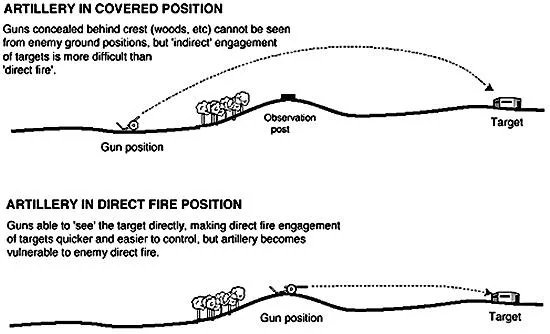
🇷🇺⚡️🇺🇦
Recently, @CITeam_en documented #Russia pulling ancient T54/55 tanks from storage and potentially moving them to the frontline in the #UkraineRussiaWar.
Some, like @RyanMcbeth, have suggested the T54/55s could substitute artillery.
My thoughts plus a twist at the end🧵
Recently, @CITeam_en documented #Russia pulling ancient T54/55 tanks from storage and potentially moving them to the frontline in the #UkraineRussiaWar.
Some, like @RyanMcbeth, have suggested the T54/55s could substitute artillery.
My thoughts plus a twist at the end🧵

What does using a tank in an indirect-fire role rather than a direct-fire role mean?
The idea: tanks don't fire at targets they can see in a relatively flat arc (as they were designed).
Instead, they fire at targets they don't see, at a steep angle (like howitzers).
The idea: tanks don't fire at targets they can see in a relatively flat arc (as they were designed).
Instead, they fire at targets they don't see, at a steep angle (like howitzers).

And Tanks do that!
For example, Russia has been experimenting with using T-90s for indirect fire in 2018 (via: @pmakela1): function.mil.ru/news_page/coun…
And Ukraine has been doing the same in Donbas (via @RUSI_org): rusi.org/explore-our-re…
For example, Russia has been experimenting with using T-90s for indirect fire in 2018 (via: @pmakela1): function.mil.ru/news_page/coun…
And Ukraine has been doing the same in Donbas (via @RUSI_org): rusi.org/explore-our-re…
Here is even an image of a T55 in Afghanistan firing in an indirect role and a view through its scope.
(Credit: Mike Bennett)
quora.com/Could-a-main-b…

(Credit: Mike Bennett)
quora.com/Could-a-main-b…


However, it's not ideal for a tank to fire in an indirect role.
Primarily, to shoot furthest, the gun must be elevated to 45° - that's just physics.
In contrast, most tanks can only elevate their barrels to about 18° - resulting in ~10km being the max. range (numbers for T55)
Primarily, to shoot furthest, the gun must be elevated to 45° - that's just physics.
In contrast, most tanks can only elevate their barrels to about 18° - resulting in ~10km being the max. range (numbers for T55)
So, often times when tanks are firing beyond the line of sight (LOS), they are driven onto a ramp to increase the angle of the gun.
Here's a video of M26 Pershing tanks in the indirect fire role in Korea 1950: reddit.com/r/TankPorn/com…
Here's a video of M26 Pershing tanks in the indirect fire role in Korea 1950: reddit.com/r/TankPorn/com…

However, shooting far is not all; you must also hit a target.
Since tanks are not set up for indirect fire, they need an observer that sees the target and where the rounds impact - telling the tanks how to adjust their fire.
An observer's sketch to coordinate indirect fire👇
Since tanks are not set up for indirect fire, they need an observer that sees the target and where the rounds impact - telling the tanks how to adjust their fire.
An observer's sketch to coordinate indirect fire👇

Another challenge for tanks firing beyond LOS is that they need to correct elevation and azimuth (gun rotation).
I.e. The tanks have to turn their turrets towards the target - as seen below, at just 5km, that's just a few degrees. So the azimuth correction must be quite precise
I.e. The tanks have to turn their turrets towards the target - as seen below, at just 5km, that's just a few degrees. So the azimuth correction must be quite precise

Thus, using a tank as an artillery piece is possible, but having it fire far and accurately is not trivial.
It requires a forward observer that tells the gunner how to adjust its aim precisely - something the stock tank is not set up for.
Now it gets interesting: #China!
It requires a forward observer that tells the gunner how to adjust its aim precisely - something the stock tank is not set up for.
Now it gets interesting: #China!
China has apparently been equipping some of its tanks with a fire-control computer to facilitate their indirect-fire capabilities.
As early as 2016, #China has begun equipping some Type 96A MBTs with a rudimentary targeting calculator for indirect fire.
thepaper.cn/newsDetail_for…

As early as 2016, #China has begun equipping some Type 96A MBTs with a rudimentary targeting calculator for indirect fire.
thepaper.cn/newsDetail_for…


By 2021, the indirect-fire targeting calculator was apparently integrated into the Type 15 light tank's fire control system.
However, the Type 15 still needs a forward observer to provide a target's coordinates.
acfun.cn/a/ac18010763?f…

However, the Type 15 still needs a forward observer to provide a target's coordinates.
acfun.cn/a/ac18010763?f…


By 2022, this had changed too.
The VT4A1 MBT with an integrated #UAV was presented at the Zhuhai Air Show.
The UAV is allegedly connected to the tank's fire-control system and can be used for recon and to acquire targets for indirect fire.
k.sina.com.cn/article_140391…

The VT4A1 MBT with an integrated #UAV was presented at the Zhuhai Air Show.
The UAV is allegedly connected to the tank's fire-control system and can be used for recon and to acquire targets for indirect fire.
k.sina.com.cn/article_140391…


Based on the reporting, the Chinese development may ave been accelerated by the experiences from the #UkraineRussiaWar.
One author specifically shows a Russian BMD-4M and a Ukrainian tank being supported by a UAV while firing indirectly.
One author specifically shows a Russian BMD-4M and a Ukrainian tank being supported by a UAV while firing indirectly.

All Chinese sources have been archived.
Further sources:
thedrive.com/the-war-zone/s…. (@thedrive )
armamentresearch.com/ares-special-r… (@Arms_Research )
FM 17-12 (@USArmy )
spslandforces.com/story/?id=354
Further sources:
thedrive.com/the-war-zone/s…. (@thedrive )
armamentresearch.com/ares-special-r… (@Arms_Research )
FM 17-12 (@USArmy )
spslandforces.com/story/?id=354
CC: @Chieftain_armor, @stoa1984, @RyanMcbeth , @AbraxasSpa, @RathsRalf, @UAWeapons , @WeaponsWarfare, @RUSI_org , @TankMuseum, @SofiGaming, @DocBunker.
• • •
Missing some Tweet in this thread? You can try to
force a refresh








